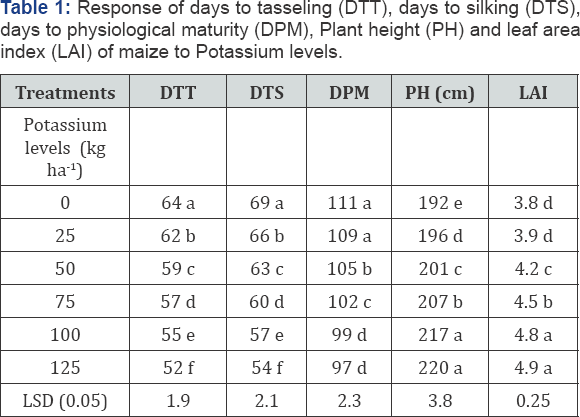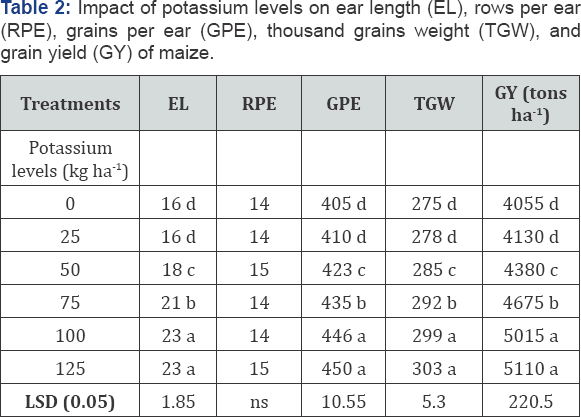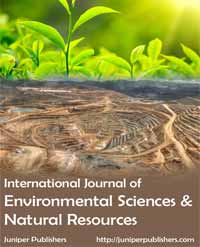Impact of Mineral Potassium on Phenology, Growth and Yield of Maize Hybrid - Juniper Publishers
Juniper Publishers- Open Access Journal of Environmental Sciences & Natural Resources
Impact of Mineral Potassium on Phenology, Growth and Yield of Maize Hybrid
Authored by Waqas Liaqat
Abstract
Potassium (K) is deficient in Pakistani soils and maize require large amount of K for healthy growth. An experiment with six levels (0, 25, 50, 75 100 and 125 kg ha-1) of K was carried out at Agronomy Research Farm of the University of Agriculture Peshawar during summer 2016. Maize hybrid Babar was sown manually on June 24. Treatments were laid out in randomized complete block design with three replications. Potassium was applied as murate of potash (MOP) during seedbed preparation. Analysis indicated a significant effect of potassium levels on maize phenology (days to tasseling, silking, maturity), growth (plant height, leaf area index), yield components (grains ear-1, 1000 grains weight) and grain yield. Data showed that with increase in K levels day to phenology decreased accordingly with maximum days in control plots. Inverse trend was found between K levels and days to phenology in maize. Maximum plant height, leaf area index, thousand grains weight, grains ear-1 and grain yield was registered for plots treated with 100 kg ha-1 K. It can be concluded from the experiment that K application at the rate of 100 kg ha-1 to maize resulted in economical and higher yield.
Keywords: Murate of potash; Babar; Ear length; Grain yield
Introduction
Maize has high yield potential and climate of Pakistan is also very favorable for maize cultivation. It is cultivated throughout the country both for grain and fodder purpose. Maize absorbs large amount of Potassium (K) after Nitrogen therefore requires K in large quantities [1]. It increases resistance to diseases and improves quality of crops [2]. Yield and yield attributes of maize is significantly affected by K [3]. Potassium substantially improves growth and productivity of maize [4]. It activates enzymes responsible for protein synthesis and photosynthesis [5]. Among other cultural practices to increase maize yield optimum rate of nutrients application plays a significant role [6]. Due to continuous growing of exhaustive crops with little application of fertilizers most of macro nutrients in soil became scarce [7]. Several surveys conducted by researchers throughout the country reported deficiency of essential nutrients like Nitrogen, Phosphorus and Potassium in soils [8]. Potassium is deficient in Pakistani soils and must be applied from external source in large quantity to achieve healthy plant growth and better yield[9].Continuous potassium mining depleted K (>37%) in soils which may cause a serious threat to agriculture in near future[10].Pakistani soils being deficient in potassium demands for better supply of K from external source. The present research was therefore conducted to sort out the optimum level of K for maize keeping in view its wide spread scarcity.
Materials and Methods
The effect of different potassium levels on the performance of maize was studied at Agronomy Research Farm of the University of Agriculture Peshawar during summer 2016. Different levels (0, 25, 50, 75 100 and 125 kg ha-1) of K were laid out in randomized complete block design. Treatments were replicated three times. Each subplot size was 5.25 m x 4 m accommodating seven rows with row to row distance of 0.75 m. Maize hybrid Babar was sown manually on June 24. Recommended dose i.e. 200 and 120 of Nitrogen and Phosphorus were applied from urea and DAP (di-ammonium phosphate) respectively. Three times manual hoeing was done with three weeks interval after sowing to control weeds population. All agronomic practices carried out during the experiment were same to all treatments. Days to tasseling and silking were recorded when 85% plants produced tassels and silks in each plot.
Days to maturity was recorded when 85% plants showed maturity in each plot. Maturity was determined by observing black mark at the end of each grain. Plant height of ten random plants was measured with measuring tape. Leaf area index was calculated by dividing leaf area on ground and multiplied with hundred for each treatment. Ear length of fifteen plants were counted in each subplot and averaged to determine ear length per treatment. Rows in fifteen sampled ears were counted and averaged for determining rows per year. Grains in fifteen ears were counted and mean value was determined. Cleaned thousand grains were weighed for each treatment to determine thousand grains weight. Four central rows for each treatment were harvested at harvest maturity, sun dried and weighed to determine biological yield. The value was converted to kgha- 1. The registered data were subjected to analysis of variance technique recommended for randomized block design and means were compared through least significant test when F-test showed significance [11].
Results and Discussion
Crop Phenology
Maize phenology i.e., days to tasseling, silking and maturity showed significant changes for different treatments of Potassium (K) as shown in (Table 1). Increasing K level decreased days to phenology in maize crop. Minimum days to phenology were recorded for highest (125 kg ha-1) level of K followed by 100 kg ha-1 K application. Maximum days to phenology were registered for control plots. An inverse relation was observed for phenology with K levels. However, days to maturity remained non-significant for 0 and 25 kg ha-1 K treated plots. Potassium activates key enzymes responsible for photosynthesis thus enhanced vegetative growth and resulted in early phenological development i.e., decreased days between emergence and phenology [12] concluded that application of potassium resulted in early phenology in maize crop [13] documented early phenological development with increase in K level.

Plant Height (cm)
Significant variations were found in plant height of maize treated with different K levels (Table 1). Tallest plants were measured in plots treated with 125 kg ha-1 K followed by plots treated with 100 kg ha-1 with no statistical significance. This was followed by plots where K was applied at the rate of 75 kg ha-1. Plants with minimum height were recorded in control plots. Potassium improves growth activities, helps in uptake of essential nutrients, promote cell division, cell enlargement and enhances crop growth rate which all contribute in boosting plant height [14,15] reported that application of potassium significantly increased plant height.
Leaf Area Index
Leaf area index (LAI) was significantly affected by various levels of potassium as exposed in (Table 1). Highest LAI was obtained in plots treated with 125 kg ha-1 K which was similar with plots treated with 100 kg ha-1 K. Lowest LAI was recorded in control plots. Application ofK enhanced leafgrowth and maintains cell osmotic potential [16]. Under optimum moisture condition K increased leaf area and thus increased leaf area index [17] reported that increasing K levels enhanced single leaf area and leaf area index due to increased amount of cellular constituent, particularly protoplasm. Also, K increased photosynthetic rate, cell division, enlargement and multiplication which significantly increased leaf area and ultimately leaf area index.
Ear Length (cm)
Potassium levels had a substantial effect on ear length of maize (Table 2). Mean data showed that highest ear length was calculated when K was applied at the rate of 125 kg ha-1 followed by K application of 100 kg ha-1. Small ears were recorded in control plots which were statistically alike with 25 kg ha-1 K application. The possible reason for lengthy ears at highest level of K might be enhanced plant growth, cell division and cell enlargements which resulted in lengthy ears [13] reported same findings of lengthy ears at highest level of K against small ears at lowest level of K.

Rows Ear-1
Impact of potassium levels on rows per ear of maize was found non-significant (Table 2). Our findings are in contrast with results of [14] that indicated significant variations in rows ear-1 of maize for different levels of K and reported maximum rows per year for 120 kg ha-1 K and minimum for control plots.
Grains Ear'1-1
Different levels of potassium significantly affected grains ear-1 of maize (Table 2). Increasing K levels significantly increased grains ear-1 of maize. More grains ear-1 was counted for K applied at the rate of 125 kg ha-1 followed by 100 kg ha-1 with non-significant differences to each other. Less grains ear-1 was registered in control plots. Potassium application increased photosynthetic activity thus more assimilates translocated towards developing grains and might resulted in more grains ear-1 [15] reported maximum grains ear-1 for highest (90 kg ha-1) level of K and minimum grains ear-1 for lowest (30 kg ha-1) rate of K.
Thousand Grains Weight (g)
Thousand grains weight was significantly affected by various levels of potassium (Table 2). Grains with maximum weight was recorded in plots which were treated with highest level of K i.e. 125 kg ha-1 which was similar in significance with 100 kg ha-1 K treated plots. This was followed by plots treated with 75 kg ha-1 K. Grains with minimum weight was recorded in control plots which was not different with plots treated with 25 kg ha-1 K [16] documented that Potassium enhances activity of enzymes responsible for accumulation and translocation of carbohydrates from source to sink and resulted in heavier grains [17] registered maximum grain weight for highest level of K and minimum for control plots.
Grain Yield (kg ha'1)
Maize crop treated with different potassium levels showed significant variations in grain yield (Table 2). Plots treated with 125 kg ha-1 K showed highest grain yield followed by plots treated with 100 kg ha-1 K. Grain yield obtained from 125 kg ha-1 and 100 kg ha-1 K treated plots did not show statistical significance from each other. Minimum grain yield was obtained from Controls plots. Application of K significantly increased grains per ear and grains weight which might led to more grain yield [18] reported that increasing K level increased grain yield in maize.
Conclusion
It is cleared from the research conducted that various levels of Potassium significantly affected crop phenology and yield. Grains per year, thousand grain weight and grain yield showed a significant and direct relation with K levels up to 100 kg ha-1 and then did not show significant increase from 100 kg ha-1 onwards. Thus, application of K at the rate of 100 kg ha-1 is efficient and resulted in better yield of maize.
To know more about Juniper Publishers please click on: https://juniperpublishers.com/manuscript-guidelines.php
For more articles in Open Access Journal of Environmental Sciences & Natural Resources please click on: https://juniperpublishers.com/ijesnr/index.php




Comments
Post a Comment